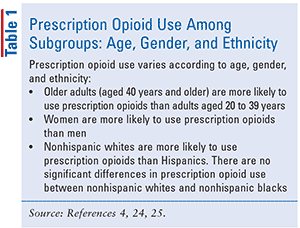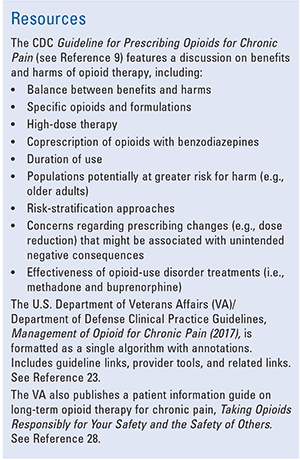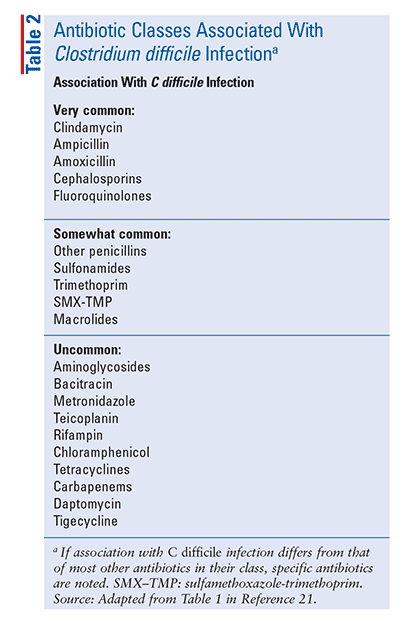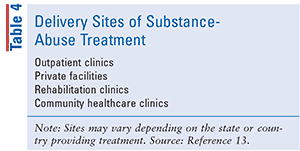US Pharm. 2018;43(2):6-9.
Although prescription opioid sales in the United States almost quadrupled between 1999 and 2014, there has not been a change overall in the amount of pain reported by Americans.1,2 Furthermore, during this time period, the number of deaths due to prescription opioid overdose has shown a similar increase.3 An estimated one in five patients with noncancer pain or pain-related diagnoses are prescribed opioids in office-based settings, with primary care providers accounting for approximately 50% of the opioid pain relievers dispensed.2 Between 2007 and 2012, there has been a steady increase in the rate of opioid prescribing among specialists, who are more likely to manage acute and chronic pain; the highest prescribing rates are among pain medicine (49%), surgery (37%), and physical medicine/rehabilitation providers (36%).2
Prescription opioid use varies among patient population subgroups, such as age, gender, and ethnicity (TABLE 1). Although prescription opioids can help manage some types of pain, there is not enough evidence that opioids improve chronic pain, function, and quality of life.4 Additionally, opioid therapy can adversely affect respiratory, gastrointestinal, musculoskeletal, cardiovascular, immune, endocrine, and central nervous systems.5
Long-term use of opioid pain relievers for chronic pain can be associated with abuse and overdose, particularly at higher dosages.4 Healthcare providers, including those in primary care settings, report concern about opioid-related risks of addiction and overdose, as well as insufficient training in pain management.4 Pharmacists can assist prescribers with their efforts in weighing the broad spectrum of health risks against an accurate assessment of observed benefits for relief of pain. This analysis can assist in discussions between clinician and patient, at which time obtaining the patient’s informed consent to opioid treatment should be considered (see Resources).
Pharmacists can provide prescribers with updated evidence regarding the benefits and harms of opioid therapy—and guidelines on prescribing opioids for chronic pain—including risk stratification approaches, specific opioids and formulations, and populations potentially at greater risk for harm (see Resources), such as older adults who might be at increased risk for falls and fractures related to opioids.6-8 Pharmacists, in the capacities of dispensing and monitoring, medication therapy management, consultant pharmacy services, and clinical coordination, among others, have an opportunity in a variety of practice settings to better serve older adults and additional populations potentially at greater risk for harm from opioids. These include patients with sleep apnea or other causes of sleep-disordered breathing; renal or hepatic insufficiency; depression or other mental health conditions; and alcohol or other substance-use disorders.9
It only requires an opioid at a therapeutic dose taken regularly over 2 to 3 days to lead to some degree of tolerance and dependence, such that when the drug is stopped, the patient may experience mild withdrawal symptoms that are barely noticed or are similar to flu symptoms; long-term use can lead to dependence.10 Among patients prescribed long-term opioid therapy to manage chronic pain, increasing numbers of deaths are due to opioid overdose.5 There is a higher risk of overdose and other significant problems (e.g., fractures, dependence, intestinal blockages) the higher the prescribed daily dose of opioid.5
One possible explanation for this increased risk may be the greater peak effect and longer duration of action that may occur secondary to reduced renal or hepatic function, ultimately reducing the dose at which respiratory depression and overdose occurs.9,11 Even in the absence of renal disease, age-related changes in individuals aged 65 years or older, such as reduced renal function and medication clearance, result in a smaller therapeutic window between a safe dosage and one associated with respiratory depression and overdose.9,12
Abuse of Prescription Opioids
Clinicians and patients alike must acknowledge that substance abuse, currently regarded as a major healthcare and social issue, is considered one of the leading modifiable factors affecting the risk of death.13 It is also associated with increased use of healthcare resources, especially emergency medicine services.13 Most people who abuse prescription opioids get them for free from a friend or relative; it has been noted that those individuals at highest risk of overdose use prescription opioids nonmedically for 200 or more days per year (TABLE 2).2
The use of prescription opioids for medical purposes but without healthcare practitioner supervision, and use for nonmedical purposes, can lead to unintended consequences (e.g., delirium, injury), which may be particularly problematic in older adults.14
While the definition of substance abuse (TABLE 3) may be simplified—and commonly understood—as the use of a compound that modifies mood or behavior in a manner characterized by a maladaptive pattern of use, it is often potentially associated with complaints that may arise secondary to substance abuse and require treatment. Opioid-use disorder involves compulsive, long-term self-administration of opioids for nonmedical purposes. The Diagnostic and Statistical Manual of Mental Disorders, Fifth Edition identifies an opioid-use disorder if a patient’s pattern of use causes clinically significant impairment or distress as manifested by the presence of particular characteristics over a 12-month period (see Reference 14).

Potential Cardiovascular Considerations
Opioid therapy can adversely affect respiratory, gastrointestinal, musculoskeletal, cardiovascular, immune, endocrine, and central nervous systems.5 Long-term opioid use may aggravate the risk of cardiovascular disease by elevating low-density lipoproteins and free triglycerides; these biochemical hallmarks are associated with an increased risk of atherosclerosis, cerebrovascular ischemia, and myocardial infarction.15 This potential risk may be of particular concern in older adults. According to Aghadavoudi and colleagues, 117 patients requiring a coronary artery bypass who also abused opium were compared with 208 similar patients who did not abuse this substance; the researchers found that low-density lipoprotein and average triglyceride levels were significantly higher in substance-abusing patients.16 (The prevalence of diabetes in opium-addicted patients was considerably lower, as were glucose levels; mean body mass index was also significantly lower in addicted individuals.) They concluded that there may be a relationship between opium abuse and worsening lipid profile, hypercholesterolemia, and coronary artery disease.16
Contributing to Cardiovascular Disease: Why Alcohol Matters
Alcohol abuse—affected by gene variations for aldehyde dehydrogenase (a major enzyme involved in alcohol metabolism)—is not only a risk factor in the development of hypertension but may also lead to cardiomyopathy (i.e., heart failure).17-19 Heavy alcohol consumption is also associated with arrhythmias, cerebrovascular hemorrhage, peripheral artery disease, and death associated with acute cardiovascular events.20
When substance abuse is complicated by additional medical problems such as cardiovascular disease, serious complications and even death may ensue; substance-abuse treatment may provide an opportunity to identify, assess, and manage these other, associated medical problems, including cardiovascular disease. Since simultaneously existing health and social problems may interfere with a substance-abuse treatment response, it has been recommended that integration of social, medical, and mental health support services be provided as a comprehensive approach in drug-treatment programs.21 Substance-abuse treatment is delivered at sites that may vary depending on the state or country providing treatment (TABLE 4). Regarding the simultaneous management of cardiovascular disorder and substance abuse, the patient is often optimally served by guidance from qualified healthcare professionals who may specialize in either.13
Case of Opioid Withdrawal–Induced Cardiomyopathy
Takotsubo cardiomyopathy (TC) is a transient, nonischemic cardiomyopathy usually seen in postmenopausal females in situations caused by stress; importantly, regarding the current opioid crisis, Olson and colleagues indicate this condition may have a predilection for patients with dependency disorders.22 While apical ballooning of the left ventricle typically occurs in TC, it is accompanied by electrocardiographic changes and enzyme release without evidence of obstructive coronary artery disease.22 These researchers report a case in which TC was induced by withdrawal from opioid medications, followed by symptom resolution subsequent to restarting maintenance opioid therapy.22 In light of the prevalence of both recreational and iatrogenic opioid use, Olson and colleagues encourage healthcare professionals to be aware of this possibility in this particular patient population, particularly when cardiovascular symptomatology has been demonstrated in these individuals.22 They further note that in the presence of cardiac symptomatology, there should be a high index of suspicion for opioid-withdrawal induced cardiomyopathy.
Conclusion
With regard to the use of opioids in the treatment of chronic pain, in addition to the recommendations presented in the current 2016 CDC Guideline for Prescribing Opioids for Chronic Pain, additional research needs to provide high-quality evidence for clinical practice regarding the long-term benefits of opioid therapy, clarification on the risks and management of potential adverse effects, including cardiovascular disease, as well as guidance on drug selection and dosing for specific medical conditions and special populations and circumstances.
REFERENCES
1. Chang H, Daubresse M, Kruszewski S, et al. Prevalence and treatment of pain in emergency departments in the United States, 2000–2010. Amer J Emergency Med. 2014;32(5):421-431.
2. Daubresse M, Chang H, Yu Y, et al. Ambulatory diagnosis and treatment of nonmalignant pain in the United States, 2000–2010. Med Care. 2013;51(10):870-878.
3. CDC. Vital signs: overdoses of prescription opioid pain relievers—United States, 1999–2008. MMWR. 2011;60(43);1487-1492.
4. CDC. Vital signs: variation among states in prescribing of opioid pain relievers and benzodiazepines—United States, 2012. MMWR. 2014;63(26):563-568.
5. Baldini A, Von Korff M, Lin EHB. A review of potential adverse effects of long-term opioid therapy: a practitioner’s guide. Prim Care Companion CNS Disord. 2012;14(3). Epub June 14, 2012. www.ncbi.nlm.nih.gov/pmc/articles/PMC3466038/. Accessed January 1, 2018.
6. Rolita L, Spegman A, Tang X. Greater number of narcotic analgesic prescriptions for osteoarthritis is associated with falls and fractures in elderly adults. J Am Geriatr Soc. 2013;61:335-340.
7. Vestergaard P, Rejnmark L, Mosekilde L. Fracture risk associated with the use of morphine and opiates. J Intern Med. 2006;260:76-87.
8. Spector W, Shaffer T, Potter DE, et al. Risk factors associated with the occurrence of fractures in U.S. nursing homes: resident and facility characteristics and prescription medications. J Am Geriatr Soc. 2007;55:327-333.
9. CDC Guideline for Prescribing Opioids for Chronic Pain—United States, 2016. Recommendations and Reports / March 18, 2016 / 65(1);1-49. www.cdc.gov/mmwr/volumes/65/rr/rr6501e1.htm.
10. Beers MH, Porter RS, Jones TV, et al. The Merck Manual of Diagnosis and Therapy. 18th ed. Whitehouse Station, NJ: Merck Research Laboratories; 2006:1696-1697.
11. Goodman LS, Limberd LE. Goodman and Gilman’s the Pharmacologic Basis of Therapeutics. 9th ed. New York, NY: McGraw-Hill; 1996.
12. Rowe JW, Andres R, Tobin JD, et al. The effect of age on creatinine clearance in men: a cross-sectional and longitudinal study. J Gerontol. 1976;31:155-163.
13. Complications, conditions & treatment of substance abuse & cardiovascular disease. American addiction centers. https://americanaddictioncenters.org/substance-abuse-cardiovascular-disease/#defined. Accessed December 15, 2017.
14. O’Malley G, O’Malley R. Opioid use disorder and rehabilitation. Merck Manual. Last full review/revision January 2016. www.merckmanuals.com/professional/special-subjects/recreational-drugs-and-intoxicants/opioid-use-disorder-and-rehabilitation. Accessed January 7, 2018.
15. Baldo G, Giunco S, Kontothanassis D, et al. Different apoprotein(a) isoform proportions in serum and carotid plaque. Atherosclerosis. 2007;193(1):177-185.
16. Aghadavoudi O, Eizadi-Mood N, Najarzadegan MR. Comparing cardiovascular factors in opium abusers and non-users candidate for coronary artery bypass graft surgery. Adv Biomed Res. 2015;4:12.
17. Frishman WH, Del Vecchio A, Sanal S, Ismail A. Cardiovascular manifestations of substance abuse: part 2: alcohol, amphetamines, heroin, cannabis, and caffeine. Heart Dis. 2003;5(4):253-271.
18. Hu N, Zhang Y, Nair S, et al. Contribution of ALDH2 polymorphism to alcoholism-associated hypertension. Recent Pat Endocr Metab Immune Drug Discov. 2014;8(3):180-185.
19. O’Connor AD, Rusyniak DE, Bruno A. Cerebrovascular and cardiovascular complications of alcohol and sympathomimetic drug abuse. Med Clin North Am. 2005;89(6):1343-1358.
20. Wakabayashi I, Sotoda Y. [Alcohol drinking and peripheral arterial disease of lower extremity. Abstract]. Nihon Arukoru Yakubutsu Igakkai Zasshi. 2014;49(1):13-27.
21. Onyeka IN, Beynon CM, Uosukainen H, et al. Coexisting social conditions and health problems among clients seeking treatment for illicit drug use in Finland: The HUUTI study. BMC Public Health. 2013;13:380-380.
22. Olson PC, Agarwal V, Lafferty JC, et al. Takotsubo Cardiomyopathy precipitated by opiate withdrawal. Heart Lung. 2018;47(1):73-75.
23. U.S. Department of Veterans Affairs/Department of Defense Clinical Practice Guidelines: Management of Opioid Therapy (OT) for Chronic Pain (2017). www.healthquality.va.gov/guidelines/pain/cot/. Accessed January 7, 2018.
24. Frenk SM, Porter KS, Paulozzi LJ. Prescription opioid analgesic use among adults: United States, 1999–2012. National Center for Health Statistics Data Brief, February 2015.
25. Paulozzi LJ, Strickler GK, Kreiner PW, Koris CM. Controlled substance prescribing patterns—prescription behavior surveillance system, Eight States, 2013. MMWR Surveill Summ. 2015;64(8):1-14.
26. Onyeka IN, Beynon CM, Ronkainen K, et al. Hospitalization in a cohort seeking treatment for illicit drug use in Finland. J Subst Abuse Treat. 2015.
27. Matsumori A. Role of hepatitis C virus in cardiomyopathies. Ernst Schering Res Found Workshop. 2006(55):99-120.
28. U.S. Department of Veterans Affairs. VA National Pain Management Program. Taking Opioids Responsibly for Your Safety and the Safety of Others. www.va.gov/PAINMANAGEMENT/docs/TakingOpioidsResponsibly20121017.pdf.
To comment on this article, contact rdavidson@uspharmacist.com.









